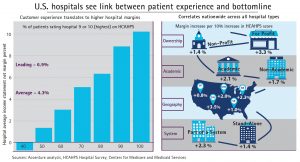
Hospital margins can increase 50% if health providers offer patients a better customer experience, Accenture calculates in the paper, Insight Driven Health – Hospitals see link between patient experience and bottom line.
Specifically, hospitals with HCAHPS scores of 9 or 10, the highest recommendations a patient can give in the survey, more likely enjoy higher margins (upwards of 8%). The Hospital Computer Assessment of Healthcare Providers and Systems (HCAHPS) survey is administered by the Centers for Medicare and Medicaid Services (CMS) and measures patients’ exeperiences in hospital post-discharge.
The correlation, simply put, is “Happy Patients, Healthy Margins,” Accenture coined in the report, and it works across all kinds of hospitals — for-profit and non-profit, academic medical centers and rural non-teaching institutions, system members and standalone providers.
Accenture offers six recommendations to hospitals for engaging patients — now, health consumers:
- Put patients first, delivering experiences people appreciate
- Inspire staff, empowering employees to be patient-centered
- Build trust and loyalty, showing consumers the top goal is their health and welfare
- Embed digital “everywhere,” meeting people where they are in their lives
- Make it easy, streamlining care and information, including financial
- Continuously innovate, going beyond the bricks-and-mortar institution.
To develop these insights, Accenture analyzed HCAHPS scores between 2008 and 2013 and CMS-reported hospital margins during the period.
Health Populi’s Hot Points: “Patient engagement” has many definitions; let’s turn to the Picker Institute Principles — seven primary dimensions of patient-centered care which date back to the 1980s:
- Respect for patients’ values, preferences and expressed needs
- Coordination and integration of care
- Information, communication and education
- Physical comfort
- Emotional support and alleviation of fear and anxiety
- Involvement of family and friends
- Transition and continuity.
In 1987, “Access to care” was added to these.
Thirty+ years later, market forces are converging to drive us back to what should have always been common sense: respect patients, their values and needs; coordinate care; keep people informed and educated; comfort them; be emotionally tuned-in and listen; involve the social network for support, empathy and care; and, foster safe transitions.
Finally, ensure access to health services.
Accenture’s research demonstrates the hard dollar value to doing these things and making patients the central “noun” in healthcare.





 Thank you, Jared Johnson, for including me on the list of the
Thank you, Jared Johnson, for including me on the list of the  I am so grateful to Tom Lawry for asking me to pen the foreword for his book, Health Care Nation,
I am so grateful to Tom Lawry for asking me to pen the foreword for his book, Health Care Nation,  Thanks to Feedspot for naming this blog, Health Populi, as a
Thanks to Feedspot for naming this blog, Health Populi, as a